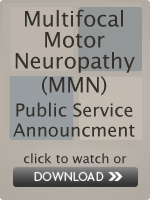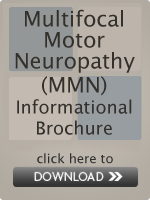

Diagnosing MMN
The diagnosis of MMN depends on demonstrating that a patient has a purely motor disorder affecting individual nerves, that there are no UMN signs, that there are no sensory deficits, and that there is evidence of conduction block. These criteria are designed to differentiate the disorder from ALS (purely motor but with UMN signs), the Lewis-Sumner Syndrome variant of Chronic Inflammatory Demyelinating Polyneuropathy (CIDP) (similar to MMN but usually with significant sensory loss), and “vasculitis” (a type of multiple mononeuropathy syndrome caused by inflammatory damage to the blood vessels in nerves that also causes sensory and motor symptoms).
A neurologist is usually needed to determine the diagnosis, which is based on the history and physical examination along with the electrodiagnostic study, which includes nerve conduction studies (NCS) and needle electromyography (EMG).
The NCS usually demonstrate conduction block. This can be done by showing that the nerve signal cannot conduct past a “lesion” at some point along the nerve. For example, if the nerve is blocked in the forearm, an electrical impulse can easily get from the wrist to the hand if the stimulus is placed at the wrist. However, the signal will be blocked from reaching the hand if the stimulus is applied at the elbow. In MMN, sensory conduction along the same path should be normal. The EMG portion of the test looks for signals in the way muscles fire. In MMN it will most likely reveal abnormalities suggesting that some percentage of the motor axons have been damaged.
Laboratory testing for GM1 antibodies is frequently done, and can be very helpful if they are abnormal. However, since only a third of patients with MMN have these antibodies, a negative test does not rule out the disorder. Spinal fluid examination is not usually helpful.


